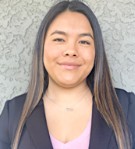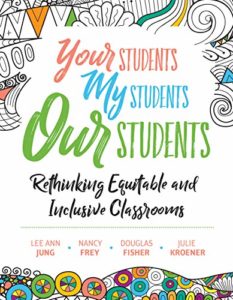Rethinking Equitable and Inclusive Classrooms
Your Students, My Students, Our Students: Rethinking Equitable and Inclusive Classrooms
By Lee Ann Jung, Nancy Frey, Douglas Fisher, and Julie Kroener
(ASCD, 2019 – Learn more)

When I first got a copy of Your Students, My Students, Our Students: Rethinking Equitable and Inclusive Classrooms, I was immediately drawn to the book. The cover and the title are both so beautiful.
The title itself gives a brief summary of the book. All students are our students, and it is time to rethink classroom settings. Lee Ann Jung, Nancy Frey, Douglas Fisher, and Julie Kroener compile experiences of students and their families in order to challenge some current special education practices and encourage educators to advocate for change of the education system.

The five disruptions to ‘business as usual’ that the authors outline include:
(1) Establish an inclusive culture that champions equity and inclusion
The first disruption discusses the current system for special education. The current system has revolved around “tracking” students and ranking them according to their mastery on certain skills. The authors urge that it is crucial to replace the one-size-fits-all model and embrace every single student as an individual.
By adjusting the language educators use in school, improving the services provided, and reconsidering the expectations set for students, educators can begin to create an inclusive culture.
As educators, we must be the dream team for our students, not the crusher of their dreams. We must not label our students; we must not let their disabilities define them because they are more than their disability.
(2) Reimagine the long-standing structure of least restrictive environment and resulting service delivery
The second disruption is all about what the least restrictive environment (LRE) is and what it may look like for each student. It is crucial for students’ learning to happen inside their LRE, whether it is in a special education classroom or in an inclusive setting among their general education peers.
However, we must understand where and how we plan for students to meet their goals. The decisions we as educators make about the environment our students will be learning in also involves bringing paraprofessionals (or a para) into the picture. The ultimate purpose of an LRE is to help ALL students and meet all their needs.
(3) Leverage the strengths of all educators to benefit each student
The authors emphasize the importance of collaboration between educators. In this section the unspoken “tension” between special education and general education teachers is discussed. This tension has risen because general and special education teachers feel as if their only responsibilities revolve around their job descriptions.
In the current status quo, the general education teacher is only in charge of the general curriculum, while the special education teacher is responsible for the accommodations each student needs. However, that should not be the case. As educators there needs to be communication among our colleagues, collaboration among all the students, and redefinition of the roles in the classroom. The students are not just “your” students or “my” students, they are OUR students, so collaboration is key!
(4) Collaborate on the delivery of instruction and intervention
In this section the authors discuss the effects of co-teaching and the trading of lead and supporting roles as needed between general and special educators. The power of co-teaching is in “what the two teachers do in the class and how they make it effective for the students” (p. 89).
The authors discuss seven co-teaching strategies: (1) one teach, one assist, (2) station teaching, (3) parallel teaching, (4) one teach, one observe, (5) supplemental teaching, (6) alternative teaching, and (7) team teaching. Another tool the authors discuss is the gradual release of responsibility (GRR) and its four steps: (1) “I do it,” (2) “We do it,” (3) “You do it together” and (4) “You do it alone.” This method allows educators to plan their lessons to meet all their students’ needs.
(5) Honor the aspirations of students and plan accordingly
In the last disruption the authors discuss how to honor the aspirations for students. Rather than tear down the dreams and aspirations students have, we must plan around them, giving students hope and reassurance that they can achieve their goals.
The question is how do we do this? It is important for educators to plan accordingly, laying out and gathering all the information needed to create the plan for the student. Throughout the process it is important to understand this gathering as a group effort. When we do this we can “communicate to the student, ‘We see you.’ It signals to families, ‘We hear you.’” (p. 123).
Your Students, My Students, Our Students is an essential tool for all educators including educators who are beginning their journey, like myself, and those who have been in the field for a long time. I personally thought it was a great read because it made me envision what I would like in my future classroom.
The authors encouraged me to picture a better system, a system where students are our priority instead of labels, a system where educators are part of one “dream team.” This is their call to action for educators. It is time to rethink equitable and inclusive classrooms for OUR students.
Esther Vences is studying to be a teacher at Pepperdine University with the hope of becoming a special education teacher.

































